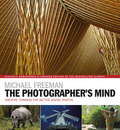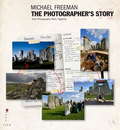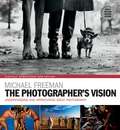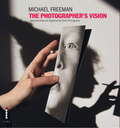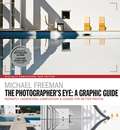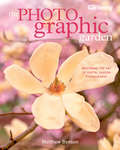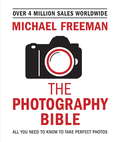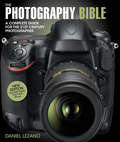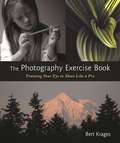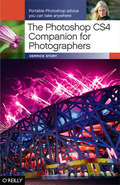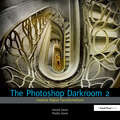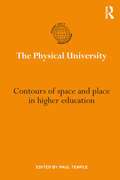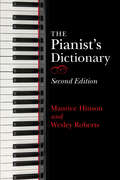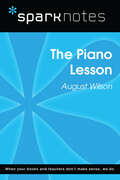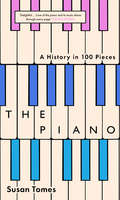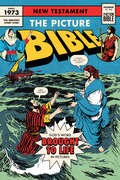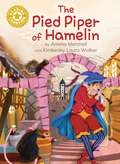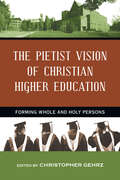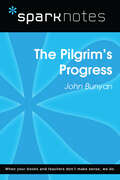- Table View
- List View
The Photographer's Mind Remastered: Creative Thinking for Better Digital Photos (The Photographer's Eye #8)
by Michael FreemanYou've done your research. You've bought your camera. You've learnt how to use it. Now what? The secret behind a good photograph is not your camera. It's not even the scene viewed through the viewfinder. It's the mind of the photographer which turns an average photograph into an exceptional one. In The Photographer's Mind, professional photographer and author Michael Freeman unravels the mystery behind the creation of a photograph and reveals how to capture photos that really make you feel something.The aim of this book is to answer what makes a photograph great, and explore the ways that top photographers achieve this goal time and time again. The Photographer's Mind will provide you with invaluable knowledge on:· Avoiding cliché· The recurring nature of trends· Style and composition· Capturing light· How to handle the unexpected
The Photographer's Story: The Art of Visual Narrative
by Michael FreemanHaving already taught you how to compose and interpret great photos, Michael Freeman now continues his best-selling series by exploring the most successful methods for presenting photography meaningfully and in an engaging format. This is the critical "next step" that separates adequate image galleries from captivating collections - and disinterested viewers from enthralled audiences.Tapping into his decades of experience shooting for such publications as Smithsonian, GEO, and Condé Nast Traveller (among many others), Michael Freeman studies the photo-essay phenomenon that took the world by storm and gave storytellers a completely new set of tools to construct their narratives. Having established how rhythm, pacing, and careful organisation build tension and cultivate interest, Freeman goes on to explain what this means for presenting your own photos, particularly in the new digital formats of online galleries, slideshows, and tablets.The Photographer's Story will enliven your images, refresh your perspective, and elevate your understanding of how photographs work together to tell a story. Your audiences will thank you for it.
The Photographer's Vision Remastered (The Photographer's Eye #3)
by Michael FreemanIn The Photographer's Vision, international bestseller Michael Freeman examines the work of photography's greats, explaining how to view a photo and how to learn from looking at it. Photographers featured include some of the most distinguished names in photography's history: Nick Knight, Frederick Henry Evans, Frans Lanting, Tim Page, Wolfgang Tillmans, Nan Goldin, Walker Evans, Cindy Sherman, Elliott Erwitt, Trent Parke, Jeff Wall, Paul Strand, Romano Cagnoni and many more, making this book visually stunning as well as intellectually rigorous.
The Photographer's Vision: Understanding And Appreciating Great Photography
by Michael FreemanIn The Photographer's Eye, Michael Freeman showed what a photographer needs to do in the instant before the shutter is released. In the sequel, The Photographer's Mind, he explained the way that professional photographers think a picture through before taking it. Both of these international best-sellers featured Michael's own photography: stunning landscapes, revealing portraits, and fascinating street photography.Now, in The Photographer's Vision, he examines the work of photography's greats, explaining how to look at a photo - and how to learn from looking at it.The featured work includes some of the most distinguished names in photography's history: Nick Knight, Frederick Henry Evans, Frans Lanting, Tim Page, Wolfgang Tillmans, Nan Goldin, Paul Outerbridge, Walker Evans, Cindy Sherman, Elliott Erwitt, Trent Parke, Jeff Wall, Paul Strand, Romano Cagnoni, Horst Faas, James Casebere and many more, making this book visually stunning as well as intellectually authoritative.
The Photographer's Vision: Understanding and Appreciating Great Photography (The\photographer's Eye Ser.)
by Michael FreemanIn The Photographer's Vision, international bestseller Michael Freeman examines the work of photography's greats, explaining how to view a photo and how to learn from looking at it. Photographers featured include some of the most distinguished names in photography's history: Nick Knight, Frederick Henry Evans, Frans Lanting, Tim Page, Wolfgang Tillmans, Nan Goldin, Walker Evans, Cindy Sherman, Elliott Erwitt, Trent Parke, Jeff Wall, Paul Strand, Romano Cagnoni and many more, making this book visually stunning as well as intellectually rigorous.
The Photographers Eye: Instantly Understand Composition & Design for Better Photography
by Michael FreemanTaking a new look at composition, the theme of his best-selling classic The Photographer's Eye, Michael Freeman now explores the visual mechanics of photography in its own native terms. Lushly illustrated with straight-to-the-point diagrams and graphic deconstructions, this book speaks in that intuitive, visual, and instantaneous language in which photographers think and work. Each section is organised into discrete units that articulate a working method for communicating particular ideas and capturing certain subjects. Dive into beautiful images and explore how each compositional element is placed and arranged in relationship to each other. Examine the outtakes from each shoot to understand why one particular image succeeded, compared to those shot before and after. Track the viewer's eye as it moves throughout the photo to see the optical dynamics held within each frame. And most of all, internalise this graphic language so you can instantly recognise amazing and powerful shots as they appear in your own viewfinder.
The Photographers Eye: Instantly Understand Composition & Design for Better Photography (The Photographer's Eye #5)
by Michael FreemanTaking a new look at composition, the theme of his bestselling classic The Photographer's Eye, Michael Freeman now explores the visual mechanics of photography in its own native terms. Lushly illustrated with straight-to-the-point diagrams and graphic deconstructions, this new, digitally remastered edition speaks in that intuitive, visual, and instantaneous language in which photographers think and work.Each section is organized into discrete units that articulate a working method for communicating particular ideas and capturing certain subjects. Dive into beautiful images and explore how each compositional element is placed and arranged in relationship to each other. Examine the outtakes from each shoot to understand why one particular image succeeded, compared to those shot before and after. Track the viewer's eye as it moves throughout the photo to see the optical dynamics held within each frame. And most of all, internalize this graphic language so you can instantly recognise amazing and powerful shots as they appear in your own viewfinder.
The Photographic Garden: Mastering the Art of Digital Garden Photography
by Matthew BensonThe garden is a rich canvas of visual ideas, all waiting to be skillfully captured and evoked by the camera. With in-depth discussions on creative technique and technical literacy, The Photographic Garden is an inspiring guide for understanding the complexities of light and design in the garden and a primer on the latest digital image-making tools, from cameras to postproduction software. Professional photographer Matthew Benson shows you how to become a better, more intuitive artist in the landscape; helps you foster a deeper understanding of design and aesthetics; and encourages you to develop your own visual sensibility—through hundreds of his own thoughtprovoking, evocative garden images. You'll learn how to explore the garden with your camera; how to apply the fundamentals of composition, light, and color to image-making; and how to use digital technology to improve and enhance (and even rescue!) the images you've taken. Most of all, you'll be motivated to see like a camera, work like a professional, and imagine and create like an artist.
The Photography Bible
by Michael FreemanCreated by expert professional photographer Michael Freeman, this convenient book is divided into the four essential areas for photographers to understand; the exposure, light & lighting, composition and editing. It's quick and easy to refer to in the field, by the computerIn a convenient take-anywhere format, this book packs in a lot of value for anyone interested in photography, and without skimping on quality. You'll find how to get great portraits, perfect landscapes and take outstanding artistic compositions; important information whatever camera you choose.
The Photography Bible: A Complete Guide for the 21st Century Photographer
by Daniel LezanoEverything you need to know about photography in the 21st centuryDiscover the different types of cameras available and how they work, from digital cameras and the latest DSLRs to Compact System Cameras and iPhonesLearn how to choose the most essential camera accessories for the modern photographer, including lenses, flashguns, studio lighting and tripodsFilled with invaluable techniques and expert advice on how to shoot a broad range of subjects, use a variety of equipment and effectively manipulate images using the latest softwareThis fully revised edition of The Photography Bible brings you up-to-the-minute information on the rapidly changing world of photography, including the latest digital cameras, the emergence of Compact System Cameras and imaging mobile phones, photography apps, software, equipment and accessories.This comprehensive guide offers expert photographic advice to help improve your photography and develop your skills, from shooting magical black and white images or capturing wildlife to composing beautiful landscapes and perfect portraits. Daniel Lezano illustrates his clear, concise techniques throughout with a selection of stunning photographs.Whether you are a newcomer to photography or an experienced enthusiast, and whether you use a mobile phone, DSLR or CSC, The Photography Bible is the ultimate reference to the most recent hardware, software and photographic techniques.
The Photography Exercise Book: Training Your Eye to Shoot Like a Pro
by Bert KragesSince the beginning of the twentieth century, photographic composition has been taught mostly by applying principles from the field of graphic design. But the factor that distinguishes the work of master photographers is their ability to see and describe scenes visually. This book follows contemporary educational methods used to teach fine arts such as drawing and painting, concentrating on teaching the perception of critical visual elements and understanding how they will be rendered photographically. <p><p> Unlike other composition resources, The Photography Exercise Book uses cognitive science to help photographers develop greater artistic proficiency. In this thoroughly revised new edition, lessons are presented as a series of exercises sure to help photographers see and perceive their environment differently. <p> Illustrated by more than 250 color photographs, and covering a wide variety of genres including street documentary, photojournalism, nature, landscape, sports, and still-life photography, this informative guide will help photographers develop cognitive skills and take compelling photos.
The Photography Teacher's Handbook: Practical Methods for Engaging Students in the Flipped Classroom (Photography Educators Series)
by Garin HornerThe Photography Teacher’s Handbook is an educator’s resource for developing active, flipped learning environments in and out of the photo classroom, featuring ready-to-use methods to increase student engagement and motivation. Using the latest research on the cognitive science of effective learning, this book presents groundbreaking strategies to inspire students to collaborate, explore, and internalize photographic principles and concepts. The innovative practices in this book reimagine the traditional, scholarly pedagogy into a dynamic, teacher-guided, learner-centered approach. Key features include: Step-by-step instructions that explain how and why to flip a photography classroom Hands-on exercises and activities to help students take charge of their learning experience Practical advice from more than 100 respected photography educators An interactive companion website with informative videos, links, and resources for students and educators alike
The Photoshop CS4 Companion for Photographers: Portable Photoshop Advice You Can Take Anywhere
by Derrick Story"Derrick shows that Photoshop can be friendly as well as powerful. In part, he does that by focusing photographers on the essential steps of an efficient workflow. With this guide in hand, you'll quickly learn how to leverage Photoshop CS4's features to organize and improve your pictures." -- John Nack, Principal Product Manager, Adobe Photoshop & Bridge Many photographers -- even the pros -- feel overwhelmed by all the editing options Photoshop provides. The Photoshop CS4 Companion for Photographers pares it down to only the tools you'll need most often, and shows you how to use those tools as part of an efficient and enjoyable workflow. This book explains an easy method for processing your images using the new user-friendly features that come with Photoshop CS4, including Adobe Bridge, Photo Downloader, and Adobe Camera Raw. A perfect fit for your laptop bag, this guide is designed to help you process photos in the field. Professional photographer and bestselling author Derrick Story teaches you how to quickly and efficiently organize and edit your photos without compromising the originals. With this book, you will: Import your images and apply metadata with Photo Downloader Rate your images and add keywords with Adobe Bridge Make basic (and reversible) edits with Adobe Camera Raw, such as cropping, color balance, and tonal adjustments Use advanced ACR tools for black & white conversion, spot removal, batch processing, and more Refine your images with Photoshop using adjustment layers, masking, and smart objects Apply advanced Photoshop techniques for retouching portaits, swapping colors, correcting lens distortion, and much more To use Photoshop effectively, photographers must know which tools they really need and which ones they don't. The Photoshop CS4 Companion for Photographers gives you the knowledge to create your own efficient path to great-looking photos.
The Photoshop Darkroom 2: Creative Digital Transformations
by Harold DavisAward-winning photography/design team Harold and Phyllis Davis are back with a brand new volume in their new Photoshop Darkroom series. Picking up where their best-selling first book left off, The Photoshop Darkroom 2: Advanced Digital Post-Processing will show you everything you need to know to take your digital imaging skills to the next level. Great photographers know that the best images begin well before the shutter clicks, and certainly well before Photoshop boots up. Harold takes a step back, and shares his helpful tips for capturing the most compelling images possible by keeping in mind what type of post-processing you'll do before you start shooting. You'll also find complete coverage of important topics such as compositing, working with layers, and HDR. Packed with tons of eye-popping images which have won Harold national acclaim, this is a fantastic resource for photographers who want to think outside the box and create truly stunning artwork.
The Physical University: Contours of space and place in higher education (International Studies in Higher Education)
by Paul TempleThe great universities of the world are to a large extent defined in the public imagination by their physical form: when people think of a university, they usually think of a distinctive place, rather than about say the teaching or the research that might go on there. This is understandable, both because universities usually stay rooted to the same spot over the centuries; and because their physical forms may send powerful messages about the kind of places they are. The physical form of the university, and how the spaces within it become transformed by their users into places which hold meanings for them, has become of increased interest recently from both academic and institutional management perspectives, when trying to understand more about how universities work, and how they may be made more effective. Yet, despite its seemingly obvious importance, the available literature on space and place in higher education internationally is scant when compared to that dealing with, say, teaching and learning methods, or with evaluating quality, or many other topics. This book brings together a range of academic and professional perspectives on university spaces and places, and show how technical matters of building design, maintenance and use interact with academic considerations on the goals of the university. Space issues are located at an intellectual crossroads, where widely differing conceptual and professional perspectives meet, and need to be integrated and this important book brings together perspectives from around the world to show design and use issues are changing Higher Education.. Globally, higher education is being required to do more things – to teach more students, to be better at research, to engage more with business and communities; and many other things. These pressures are leading universities to reconsider their management processes, as well as their academic structures: an often-quoted saying is that "we make our buildings, and afterwards they make us". At a time when universities and colleges are seeking competitive advantages, ideas and analysis about space design and use is much needed and will be well-received.
The Physical World: An Introduction to Physical Science (formerly Basic Science)
by David Hurd Donovan Hadaway John E. Jenkins George Mulfinger Jr.Physical Science encourages students to see matter and energy as part of God's creation. Students first study elementary chemistry, discussing the structure and interactions of matter and defining chemical and nuclear energy. Then they focus on elementary physics and the other six forms of energy. This is a laboratory course that includes many hands-on experiments and demonstrations.
The Pianist's Dictionary
by Maurice Hinson Wesley RobertsFrom A to Z to middle C: An &“essential reference&” for piano students, teachers, players, and music lovers, with hundreds of definitions (E.L. Lancaster, Alfred Music).The Pianist&’s Dictionary is a handy and practical reference dictionary aimed specifically at pianists, teachers, students, and concertgoers. Prepared by Maurice Hinson and Wesley Roberts, this revised and expanded edition is a compendium of information gleaned from a combined century of piano teaching. Users will find helpful and clear definitions of musical and pianistic terms, performance directions, composers, pianists, famous piano pieces, and piano makers. The authors&’ succinct entries make The Pianist&’s Dictionary the perfect reference for compiling program and liner notes, studying scores, and learning and teaching the instrument. &“This new edition is a go-to source for piano scholars and students for quick information on musical terms, pianists, major works in the piano repertoire, piano manufacturers, and more . . . comprehensive, easy to use.&” —Jane Magrath, University of Oklahoma
The Piano Lesson (SparkNotes Literature Guide Series)
by SparkNotesThe Piano Lesson (SparkNotes Literature Guide) by August Wilson Making the reading experience fun! Created by Harvard students for students everywhere, SparkNotes is a new breed of study guide: smarter, better, faster. Geared to what today's students need to know, SparkNotes provides: *Chapter-by-chapter analysis *Explanations of key themes, motifs, and symbols *A review quiz and essay topicsLively and accessible, these guides are perfect for late-night studying and writing papers
The Piano: A History in 100 Pieces
by Susan TomesA fascinating history of the piano explored through 100 pieces chosen by one of the UK&’s most renowned concert pianists An astonishingly versatile instrument, the piano allows just two hands to play music of great complexity and subtlety. For more than two hundred years, it has brought solo and collaborative music into homes and concert halls and has inspired composers in every musical genre—from classical to jazz and light music. Charting the development of the piano from the late eighteenth century to the present day, pianist and writer Susan Tomes takes the reader with her on a personal journey through 100 pieces including solo works, chamber music, concertos, and jazz. Her choices include composers such as Bach, Mozart, Beethoven, Robert Schumann, Tchaikovsky, Debussy, Gershwin, and Philip Glass. Looking at this history from a modern performer&’s perspective, she acknowledges neglected women composers and players including Fanny Mendelssohn, Maria Szymanowska, Clara Schumann, and Amy Beach.
The Picture Bible New Testament (Picture Bible)
by Iva HothFor nearly 50 years and with more than 3 million copies in print, The Picture Bible has transformed lives around the world through its fast-paced, easy-to-read narrative and comic-style illustrations.Now with beautifully refreshed packaging, this New Testament edition offers:74 stories in full-color comic formatmaps, a Scripture index, a biblical timeline, and “Did You Know?” fact pagesan engaging style that appeals to adults who are new to the Bible as well as to kids and teens Continuing the remarkable legacy of The Picture Bible, this stand-alone New Testament serves as an ideal evangelism tool for churches and outreaches, a great book for family Bible time, and a trustworthy first Bible for anyone who needs to know the powerful love of Jesus.
The Picture of Dorian Gray (SparkNotes Literature Guide Series)
by SparkNotesThe Picture of Dorian Gray (SparkNotes Literature Guide) by Oscar Wilde Making the reading experience fun! Created by Harvard students for students everywhere, SparkNotes is a new breed of study guide: smarter, better, faster. Geared to what today's students need to know, SparkNotes provides: *Chapter-by-chapter analysis *Explanations of key themes, motifs, and symbols *A review quiz and essay topicsLively and accessible, these guides are perfect for late-night studying and writing papers
The Pied Piper of Hamelin: Independent Reading Gold 9 (Reading Champion #516)
by Amelia MarshallThis story is part of Reading Champion, a series carefully linked to book bands to encourage independent reading skills, developed with Dr Sue Bodman and Glen Franklin of UCL Institute of Education (IOE)Reading Champion offers independent reading books for children to practise and reinforce their developing reading skills.Fantastic, original stories are accompanied by engaging artwork and a reading activity. Each book has been carefully graded so that it can be matched to a child's reading ability, encouraging reading for pleasure.
The Pietist Vision of Christian Higher Education: Forming Whole and Holy Persons
by Christopher GehrzPietism has long been ignored in evangelical scholarship. This is especially the case in the field of Christian higher education, which is dominated by thinkers in the Reformed tradition and complicated by the association of Pietism with anti-intellectualism. The irony is that Pietism from the beginning "was intimately bound up with education," according to Diarmaid MacCulloch. But until now there has not been a single work dedicated to exploring a distinctively Pietist vision for higher education. In this groundbreaking volume edited by Christopher Gehrz, scholars associated with the Pietist tradition reflect on the Pietist approach to education. Key themes include holistic formation, humility and openmindedness, the love of neighbor, concern for the common good and spiritual maturity. Pietism sees the Christian college as a place that forms whole and holy persons. In a pluralistic and polarized society, such a vision is needed now more than ever.
The Pigeon HAS to Go to School! (Pigeon Ser.)
by Mo WillemsThe Pigeon must go to school, but frets about math, learning the alphabet, heavy backpacks, and what the teacher and other birds will think of him.
The Pilgrim's Progress (SparkNotes Literature Guide Series)
by SparkNotesThe Pilgrim's Progress (SparkNotes Literature Guide) by John Bunyan Making the reading experience fun! Created by Harvard students for students everywhere, SparkNotes is a new breed of study guide: smarter, better, faster. Geared to what today's students need to know, SparkNotes provides: *Chapter-by-chapter analysis *Explanations of key themes, motifs, and symbols *A review quiz and essay topicsLively and accessible, these guides are perfect for late-night studying and writing papers
